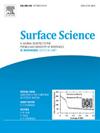Ge(110) c(8×10)重建通过振动稳定
IF 2.1
4区 化学
Q3 CHEMISTRY, PHYSICAL
引用次数: 0
摘要
确定表面的原子结构对于化学和原子尺度物理过程的可靠模拟和深入探索至关重要。本研究以Ge(110) c(8 × 10)为例,采用密度泛函理论(DFT)计算来检验振动熵在表面重建稳定性中的作用。Ge(110) c(8 × 10)单元格由基于间隙的五聚体(通用构建块模型,UBB)组成,其中散布着在STM图像中显示为未重构的区域。DFT计算预测,加入更多的五聚体会降低表面能,这与实验结果相矛盾。当考虑振动熵和在UBB五聚体之外引入表面空位时,这种差异就得到了解决。这些空位类似于早先提出的四聚体-七方环和四方环(THTR)重建模型。空位空位最近的邻居像在单原子台阶边那样重键。实验观察到,五聚体、空位和未重构表面对Ge(110) c(8 × 10)重构的振动熵差异随五聚体密度的变化而稳定。空缺的存在在概念上与Ge(110) 16×2″中单原子步骤的存在是一致的,这是该表面最稳定的重建。本文章由计算机程序翻译,如有差异,请以英文原文为准。

Ge(110) c(8×10) reconstructions stabilized by vibrations
Determining the atomic structure of a surface is essential for reliable simulations and in-depth exploration of chemical and atomic-scale physical processes. Using Ge(110) c(8 × 10) as a case study, this work employs Density Functional Theory (DFT) calculations to examine the role of vibrational entropy in surface reconstruction stability. The Ge(110) c(8 × 10) unit cell consists of interstitial-based pentamers (Universal Building Block model, UBB) interspersed with regions appearing in STM images as unreconstructed. DFT calculations predict that adding more pentamers lowers the surface energy, contradicting experimental findings. This discrepancy is resolved when vibrational entropy is accounted for and surface divacancies are introduced in addition to the UBB pentamers. These divacancies are similar to those proposed earlier in the Tetramer-Heptagonal and Tetragonal Ring (THTR) reconstruction model. The nearest neighbors of the vacancy sites are rebonded as on monatomic step edges. The differences in the vibrational entropy contributed by pentamers, divacancies, and unreconstructed surface stabilize Ge(110) c(8 × 10) reconstructions with the pentamer density observed experimentally. The presence of divacancies is conceptually consistent with the presence of monatomic steps in Ge(110) “16×2″, the most stable reconstruction of this surface.
求助全文
通过发布文献求助,成功后即可免费获取论文全文。
去求助
来源期刊

Surface Science
化学-物理:凝聚态物理
CiteScore
3.30
自引率
5.30%
发文量
137
审稿时长
25 days
期刊介绍:
Surface Science is devoted to elucidating the fundamental aspects of chemistry and physics occurring at a wide range of surfaces and interfaces and to disseminating this knowledge fast. The journal welcomes a broad spectrum of topics, including but not limited to:
• model systems (e.g. in Ultra High Vacuum) under well-controlled reactive conditions
• nanoscale science and engineering, including manipulation of matter at the atomic/molecular scale and assembly phenomena
• reactivity of surfaces as related to various applied areas including heterogeneous catalysis, chemistry at electrified interfaces, and semiconductors functionalization
• phenomena at interfaces relevant to energy storage and conversion, and fuels production and utilization
• surface reactivity for environmental protection and pollution remediation
• interactions at surfaces of soft matter, including polymers and biomaterials.
Both experimental and theoretical work, including modeling, is within the scope of the journal. Work published in Surface Science reaches a wide readership, from chemistry and physics to biology and materials science and engineering, providing an excellent forum for cross-fertilization of ideas and broad dissemination of scientific discoveries.
 求助内容:
求助内容: 应助结果提醒方式:
应助结果提醒方式:


